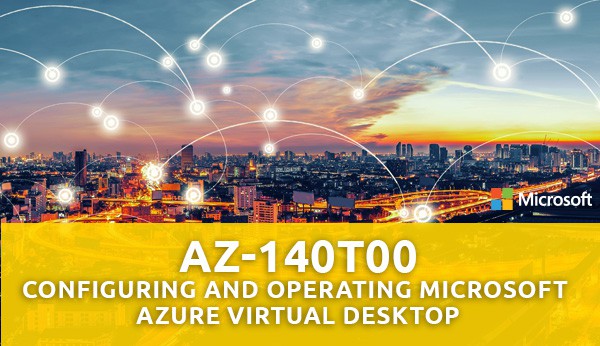
Learning Path 1: Plan a Windows Virtual Desktop Architecture
Learn how to assess existing physical and virtual desktop environments and plan for Azure Virtual Desktop client deployments. This learning path aligns with exam AZ-140: Configuring and Operating Microsoft Azure Virtual Desktop.
Modules:
- Azure Virtual Desktop Architecture
- Design the Azure Virtual Desktop architecture
- Design for user identities and profiles
Learning Path 2: Implement an Azure Virtual Desktop Infrastructure
Learn how to create host pools and apply operating system and application updates to an Azure Virtual Desktop host. This learning path aligns with exam AZ-140: Configuring and Operating Microsoft Azure Virtual Desktop.
Modules:
- Implement and manage networking for Azure Virtual Desktop
- Implement and manage storage for Azure Virtual Desktop
- Create and configure host pools and session hosts for Azure Virtual Desktop
- Create and manage session host image for Azure Virtual Desktop
Learning Path 3: Manage Access and Security for Azure Virtual Desktops
Learn how to plan and implement Azure roles for Azure Virtual Desktop and implement Conditional Access policies for remote connections. This learning path aligns with exam AZ-140: Configuring and Operating Microsoft Azure Virtual Desktop.
Modules:
- Manage access for Azure Virtual Desktop
- Manage security for Azure Virtual Desktop
Learning Path 4: Manage User Environments and Apps for Azure Virtual Desktops
Learn how to plan for FSLogix, configure Cloud Cache, and implement OneDrive for Business for a multi-session environment. This learning path aligns with exam AZ-140: Configuring and Operating Microsoft Azure Virtual Desktop.
Modules:
- Implement and manage FSLogix
- Configure user experience settings
- Install and configure apps on a session host
Learning Path 5: Monitor and maintain a WVD infrastructure for Azure Virtual Desktops
Learn how to plan and implement a disaster recovery plan, configure automation, and optimize session host capacity for Azure Virtual Desktop. This learning path aligns with exam AZ-140: Configuring and Operating Microsoft Azure Virtual Desktop.
Modules:
- Monitor and manage performance and health
- Plan and implement updates, backups, and disaster recovery
Labs: Configuring and Operating Microsoft Azure Virtual Desktop
- Lab 1: Deploy host pools and session hosts by using the Azure portal (Entra ID) (30 minutes)
- Lab 2: Manage host pools and session hosts by using the Azure portal (Entra ID) (30 minutes)
- Lab 3: Implement monitoring by using Azure Virtual Desktop Insights (25 minutes)
- Lab 4: Connect to session hosts (Entra ID) (20 minutes)
- Lab 5: Implement and monitor autoscaling of session hosts (45 minutes)
- Lab 6: Implement Azure Private Link for Azure Virtual Desktop (45 minutes)
- Lab 7: Create custom session host images by using image templates (90 minutes)
Successful Azure Virtual Desktop administrators start this role with experience in networking, compute, storage, and business continuity solutions. Before attending this course, students must have previous experience deploying or administering Azure resources and conceptual knowledge of:
- Microsoft Entra ID
- Azure compute technologies such as VMs, containers and serverless solutions
- Virtual desktop concepts and technologies
- Azure virtual networking to include load balancers
- Azure Storage technologies (unstructured and databases).
As a candidate for this certification, you should be a server or desktop administrator with subject matter expertise in designing, implementing, managing, and maintaining Microsoft Azure Virtual Desktop experience and remote apps for any device. You should have experience with Azure technologies, including:
- Compute
- Networking
- Identity
- Storage
- Resiliency
You should be able to manage end-user desktop environments, including delivering applications and configuring user settings. You should use the Azure portal, templates, scripting, and command-line tools to manage an Azure Virtual Desktop deployment.


